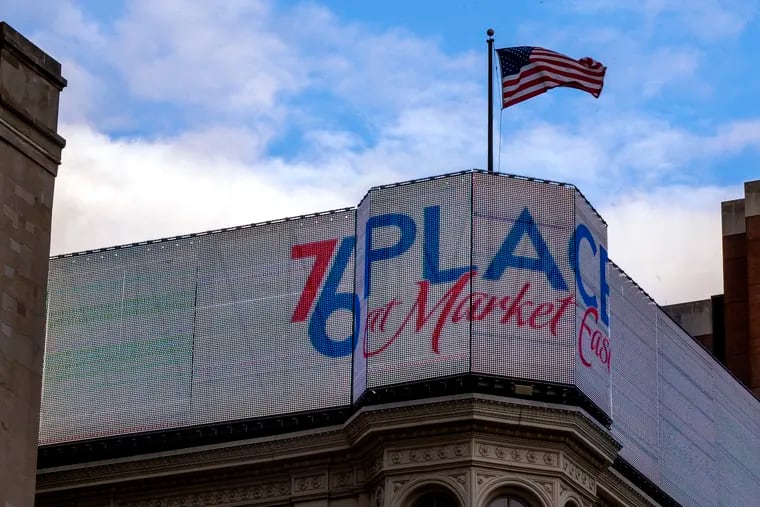The long-awaited impact studies on the controversial Sixers Arena proposal deemed the project to be “appropriate” for City centerbut could have a number of negative impacts on Chinatown.
The city-commissioned reports released Monday analyzed the arena’s potential impact in four categories: community, economic, traffic and design. They come as the City Council is in the process of should address the issue this fall.
The project has been controversial since its launch. launched two years agowith developers touting its economic benefits and opponents pointing to the project’s potential to harm an already struggling Chinatown, which sits next to the proposed site at 10th and Market Streets.
Opponents of the project have questioned the independence of the studies, which were funded by the Sixers organization. And Experts have warned that economic projections may not be realistic.
Here’s what you need to know about each study:
The arena would not require the demolition of existing housing, but could displace residents due to rising property values and the associated impacts. gentrificationaccording to the community impact study.
The neighborhood’s average median home value is already more than twice the city’s median value.
The Sixers said they would use a $50 million community benefits deal to help preserve housing affordability, small business vitality and the neighborhood’s cultural identity, but many members of the Chinatown community have expressed his opposition to the project.
Construction of a new arena would have a primarily negative impact on Chinatown’s small business corridor, according to the city’s community impact analysis.
Most industries in Chinatown would be negatively impacted, including grocery stores, financial services and health care providers. The study estimates that professional services and wholesale businesses would not be positively impacted.
Without city support, the arena would increase property values, evict former tenants and lead to a decline in Chinatown’s “cultural identity,” the study said.
The area already faces development and “dynamism” challenges unrelated to arena construction, the study said, but a Sixers arena would exacerbate the trends.
“Accordingly,” the study says, “the Arena should be considered a significant potential risk to Chinatown’s core identity.”
The transport impact study highlighted the importance of public transport and said 40% of fans have to use it rather than drive to avoid traffic jams.
The study found that if even just over 40% of fans traveled downtown, it would cause traffic jams at key intersections.
To discourage fans from driving, the study recommends providing a SEPTEMBER or a PATCO Pass with event tickets at no additional cost, excluding event ticket parking benefits and scheduling of large-scale bike or valet parking services.
The Sixers’ goal, so that 40% of supporters use public transport while another 40% drive, which is possible and would result in manageable traffic, the study said. In March, 75% of fans went to the Wells Fargo Center.
At least one pundit has questioned whether the Sixers will get a “complete reversal of behavior.”
According to the community impact study, the arena could exacerbate Chinatown’s unique traffic problems, including the car dependency of its aging population, limited parking and congestion.
The surrounding area has enough parking to meet demand, even during other downtown events such as theater productions, the study said.
The study warns: “The more parking you offer, the easier and more likely it is that arena-goers will choose to drive.”
The report suggests changing on-street parking time limits in Chinatown from three to two hours, using prepaid parking and adding 95 accessible parking spaces in the proposed arena.
According to the study, congestion caused by the proposed arena is “considered to be a minor impact on overall traffic operations” on I-676.
The consultants determined that without the arena, traffic would increase by 4%, while the arena would result in a 12% increase in traffic.
Traffic is a problem at the Wells Fargo Center. Past analyses showed a “notable increase in traffic congestion” on surrounding highways after the game compared to non-event nights.
New tax revenue estimates for school district and city
According to the economic impact report, a Market East Sixers arena would bring in $390 million in tax revenue over 30 years.
It is well below the $1.5 billion in tax revenue launched by the Sixers. The organization said it used a different cost estimation method for its figure, but has not released its study or the methodology used.
Only about $249 million, or 64 percent, would go directly to the city or state. School District of PhiladelphiaThe remaining revenue would go to the state.
In contrast, the Sixers’ own analysis found that the arena would add $800 million in tax revenue for the city and $200 million for the school district over 30 years.
The Sixers are proposing to give the land to the city and lease it back to the municipal government. That would exempt the property from property taxes that fund city services and the Philadelphia School District, and the team would instead have a payment-in-lieu-of-taxes agreement, known as a PILOT. The PILOT would begin in 2033 and raise $24 million over 30 years, the study said.
Consultants hired by the city estimated the arena would bring the city $1.9 billion in construction spending and people coming to town for events, and $593 million in income for workers from full-time jobs created.
The Sixers felt the arena would attract $400 million in annual “economic output”” and this Construction would attract more than $2 billion in “economic impact” on the city center.
According to the city’s study, a new arena would create 710 new full-time jobs in Philadelphia and 1,070 statewide.
That figure is consistent with the Sixers’ own analysis, which suggested the arena would create 1,000 direct full-time jobs once completed.
The published study said the Wells Fargo Center would suffer from the loss of Sixers games and revenue from broadcast and naming rights. But it found the Philadelphia market could support two financially viable arenas.
Based on studies in eight other cities with more than one sports arena, city consultants concluded that a new arena would increase the number of events in Philadelphia.
That increased competition could translate into an additional benefit for consumers: lower suite prices. Based on analyses of other cities, the consultants estimated that suite prices would be lower in both arenas, particularly at Wells Fargo Center because of the loss of its anchor tenant, the Sixers.
The proposed arena lacks a clear location for public gatherings and outdoor celebrations
The design impact study says the arena project is “appropriate for downtown Philadelphia, if done well.” It also notes that downtown arenas are often “disruptive in a positive way.”
The report, however, expresses concern about the lack of an outdoor public square for public gatherings or celebrations.
The study recommends creating and refining “civic and public gathering spaces” for queuing before and after events, meeting friends and other pre- and post-event activities.
Last year, the Design Advocacy Group, made up of more than 2,100 architects and building design experts, voiced its opposition to the arena. The group’s steering committee said the arena would not revitalize the East Market and could even “make things worse” for accessing the city centre.
Nicole Gainer, spokesperson for 76 Devcorp, said at the time “It is disappointing that the Design Advocacy Group Steering Committee members have issued a statement that contains several glaring inaccuracies.”

